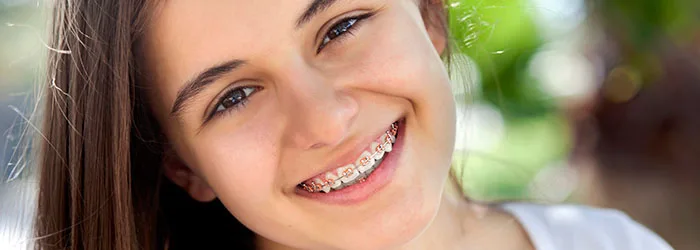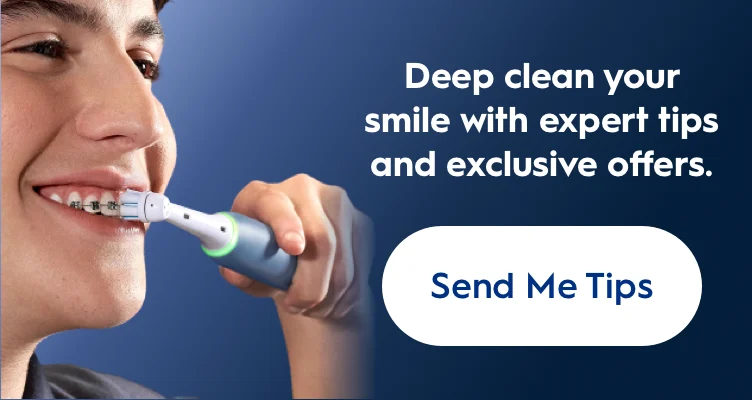
Are there any alternatives to braces?
Unfortunately, there aren't many alternatives to braces, but there are alternatives to the metal braces that many people immediately picture. You can get clear or tooth-colored brackets and wires, which make braces much less noticeable. Some patients are also eligible for Invisalign instead of traditional braces. There are also other types of removable appliances that can help align teeth.
Some adults choose to get veneers instead of braces to serve as a purely cosmetic fix. However, these are quite expensive, may need to be replaced at some point in life, and do not actually correct any bite issues.
What's the best age to get braces?
There's no set "best" age to get braces. For most kids, the best time for braces is generally between ages 10 and 14, when a child's mouth and head are still growing and the permanent teeth are erupting. The exact time depends on growth and on how quickly a child's adult teeth come in. However, braces can still be effective in older teenagers and adults.
What does "Phase I" and "Phase II" treatment mean?
Phase I, also known as "early intervention", refers to orthodontic treatment that occurs before a child has all of their permanent teeth. This usually happens between ages 7-10. Phase I treatment doesn't always function as a complete replacement for braces - its purpose is to fix problems that are most easily corrected at an early age and to make the Phase II treatment (braces) easier. To put it simply, Phase I takes care of the initial structural (skeletal) corrections so that braces can make more refined (dental) corrections and finish the job.
Some orthodontic problems like underbites/crossbites, large over bites, severe crowding, severely protruded front teeth, and narrow jaws are easier to correct at a younger age. Early correction often leads to easier and more predictable treatment after all of the permanent teeth have erupted. Early intervention can also decrease the need to extract permanent teeth in the future, correct harmful habits like thumb-sucking, tongue-thrusting, and speech problems, reduce the risk of tooth trauma to protruded front teeth, eliminate the need for later corrective surgery, and reduce teasing caused by abnormally crooked teeth.
Between Phase I and II, kids may wear a retainer or space maintainer to maintain their progress, and should continue visiting their orthodontist so he or she can check on jaw and tooth development.
Phase II, sometimes just called "active treatment", consists of full braces. It's designed to finish straightening the teeth and correcting the bite once all the permanent teeth have come in.
How long do people have to wear braces?
On average, most kids wear braces for 1 to 3 years, but this can vary greatly for each person based on growth and the severity of the problem. It also depends on the cooperation of the patient, including maintaining good oral hygiene, wearing auxiliaries such as rubber bands as directed, avoiding damaging food, and keeping all of their follow-up appointments.
I'm already an adult - should I bother with braces?
This is a subjective choice, but braces can still be quite effective for adults and modern styles are much less noticeable than the braces that many adults remember. In fact, about 20% of patients with braces are over 18. Many adults decide to get braces because they couldn't afford them as a kid and now can, or because their teeth have shifted with age. Getting braces, even as an adult, can give you decades of more attractive straight teeth and correct serious structural problems, so many people see them as a worthwhile investment.
Other than making teeth look good, are braces really necessary?
Some people may get braces for mostly cosmetic reasons but there are also a number of health benefits to straighter teeth. Straight teeth are easier to clean well, which reduces tooth decay and gingivitis. Correcting the bite also fixes many structural problems, which can reduce jaw pain and make chewing less painful.
I had braces as a kid and hated them. Are they still that bad?
No. They may not exactly be enjoyable, but they're less noticeable, less painful, and more efficient than you remember. You can now get clear brackets or Invisalign for a less noticeable look, and even "traditional" metal brackets are much smaller than in the past. New heat-activated wires move teeth with constant, more gradual pressure, so each adjustment hurts less and teeth realign more quickly. Computer technology in orthodontics has also improved greatly, giving us "smart" wires and brackets that move teeth faster and more efficiently.
Related Articles
Sign Up
for expert advice and exclusive offers








